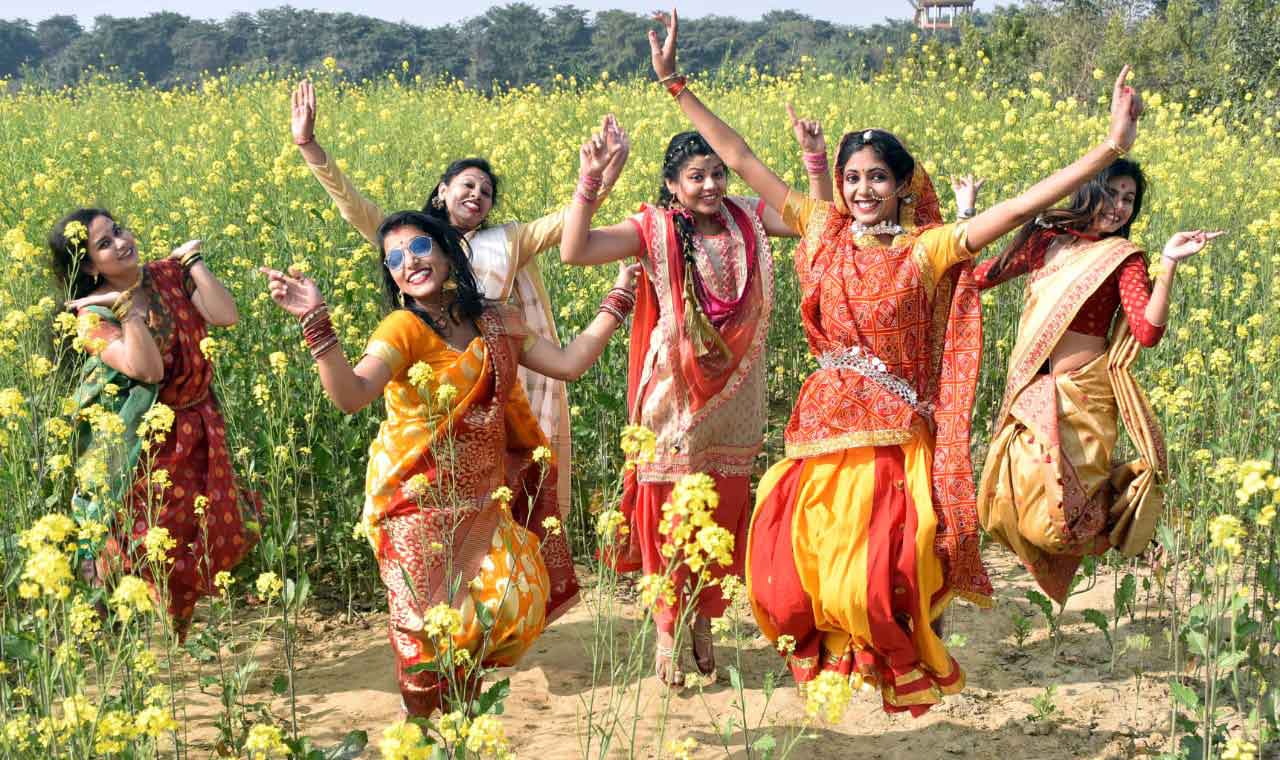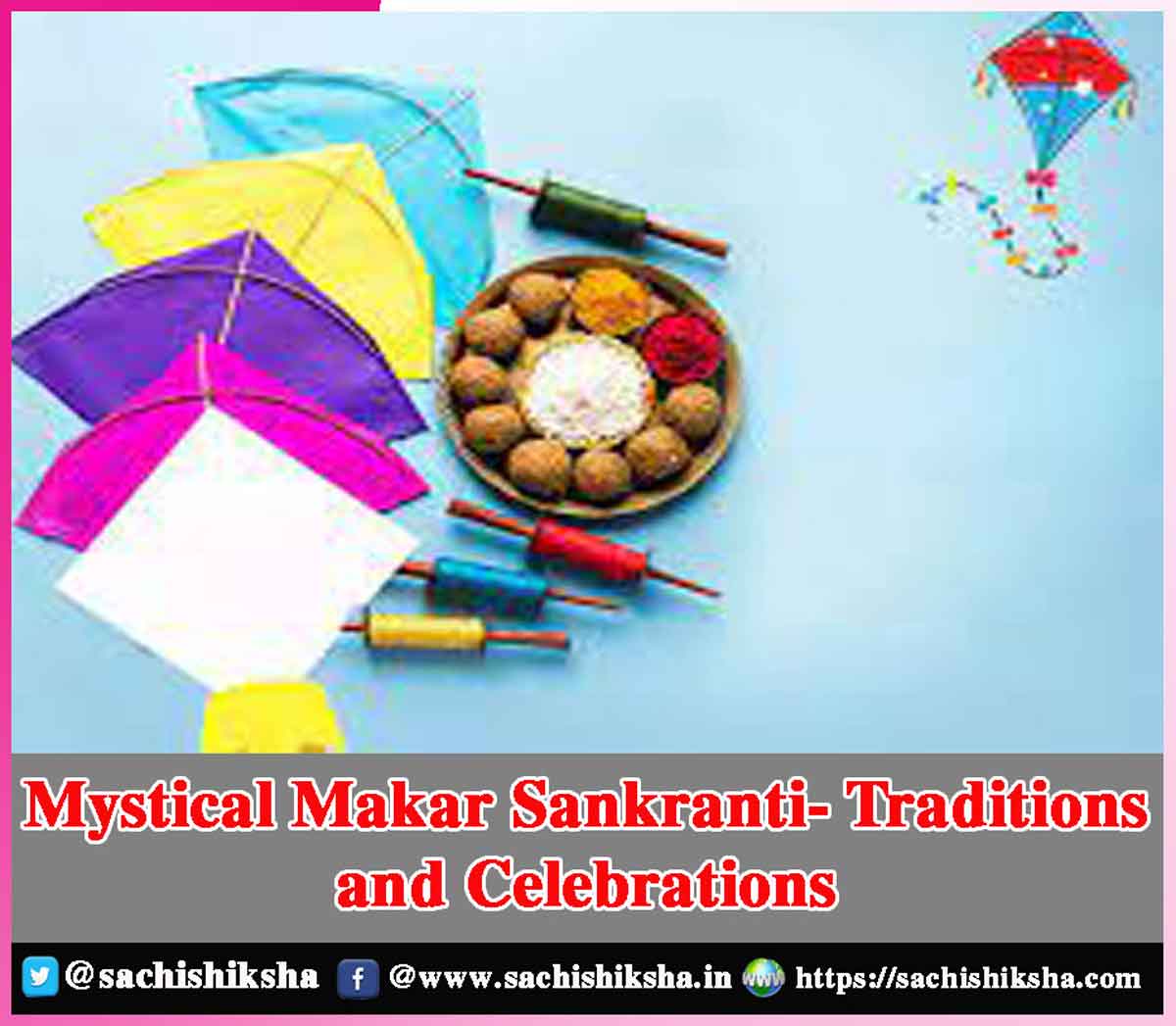Mystical Makar Sankranti- Traditions and Celebrations
Introduction: Remembering delving into those melt-in-your-mouth tilkut laddoos as a child, laughing at the tickling of ‘Are there sesame seeds on the inside of your nose’? Or snuggling up by a bursting bonfire, the smokey fragrance promising the end of winter’s chill and the arrival of warmer weather? That is the enchantment of Makar Sankranti.
Table of Contents
Association With the Sun:

Rejuvenation, Wealth & Family Ties:
During the Makar Sankranti festival, there will be multi coloured kites in the sky, grandparents assisting their grandchildren in tying the ideal kite. This ancient event, laced with strands of family, history, and the promise of regeneration, marks an important point in the year—casting off the final chills of winter and welcoming the sun’s northward march, reveling in the optimism of brighter days ahead. The Makar Sankranti festival brings together varied cultures throughout India to celebrate not just the sun’s northward trek, but also the hope of rejuvenation, wealth, and the deepening of familial ties.
Spiritual Meaning of Makar Sankranti:
Makar Sankranti has a spiritual meaning for Hindus, especially those who adore Surya, the sun deity. Despite being a celestial object, the sun represents the universal source of power, sunlight, and existence. Numerous individuals take ritualistic swims in sacred rivers on this day of prosperity, which symbolizes an inner cleansing to clear the collected sins of the soul. In mythological regions, the celebration celebrates the triumph of virtue over evil, commemorating Lord Vishnu’s epic vanquish of a demon Sankarasura.
Season for Harvesting:
Makar Sankranti marks the beginning of the season for harvesting, motivating farmers to convey their appreciation for an abundant crop and request prayers for a bright future. The celebration becomes an opportunity for people to gather together, share the happiness of wealth, and create a sense of communal appreciation.
The Custom of Raising Kites:
The custom of raising kites adds to the celebrations by symbolizing the removal of negativity and the creation of an environment full of enthusiasm and uplifting vibes. As vibrant kites fly across the sky, they represent more than simply a fun activity, but a community appreciation of increased weather and an expectation of days to come. The Makar Sankranti event is thus transformed into an artistic weaving where devotion to religion, harvest joy, and communal spirit perfectly mix thus creating a brilliant mosaic that represents the realm of developed India.
The Essence of Makar Sankranti:
Makar Sankranti essence resides in its religious significance, which represents the environment’s cyclical cycle and the social celebration of the rebirth of existence and wealth. Makar Sankranti is not commemorated on a certain date, rather according to the solar cycle.
It occurs on the day the sun enters the Capricorn zodiac signature, which is normally between January 14th and 15th of each year. The actual date of the festival may vary according to geography and estimates. This celebration has a long history, dating back to the Indian subcontinent’s mediaeval understanding of astronomy and cultivation. Makar Sankranti marks the sun’s transition into Capricorn, which signals the closing of winter and the start of daylight that is longer.
Celebration in Punjab:
Over the decades, the festival has evolved, including traditions from the region. Makar Sankranti is known in Punjab as Lohri, and it is celebrated with bonfires, customary dances, and sweet exchanges. As the Makar Sankranti heritage develops, people realize that the celebration represents timeless customs that have defined India’s ethnic makeup. Following agricultural and astronomical cycles, it displays the tenacity of social customs transmitted down through several generations, linking earlier times and modern times.
The holiday is held in several Indian states. In Punjab, the holiday takes on the bright form of Lohri, creating a lively atmosphere with bonfires that illuminate the night sky. Families come together to perform traditional dances, perform traditional tunes, and share delicious delicacies like jaggery and sesame seeds. This festival exudes compassion and friendship, capturing the essence of the state’s vibrant character.
Celebration in South India:
When you drive south to Tamil Nadu, Makar Sankranti unfolds into Pongal, a four-day harvest celebration. Families come together in a festive celebration, preparing the first crop in artistically decorated pottery pots. The surroundings is filled with the perfume of freshly cooked foods, and customary customs provide a sense of cultural holiness to the celebrations.
Celebration in Gujrat:
The International Kite Festival in Gujarat converts sky into a visually stunning tapestry of colours and shapes. Kite lovers, both domestic and international, demonstrate their abilities in a visually stunning display that attracts viewers. The event not only promotes the fine art of kite flying, but it also develops a sense of competitiveness and friendship among individuals, making it a one-of-a-kind and exciting experience.
Celebration in Maharashtra:
Makar Sankranti is celebrated in Maharashtra with an exchange of ’til-gul’, a traditional Makar Sankranti dish made with sesame seeds and jaggery. The beautiful exchange is followed by the traditional chorus “Til gul ghya, god god bola,” which encourages individuals to forget old grudges and welcome fresh opportunities. This tradition illustrates the cultural dedication to promoting unity and goodwill over the holiday season. It is clear that every state brings its own unique flavor to the celebration, highlighting the array of cultures and customs that make India so varied.
Celebration in U.P & Bihar:
In Uttar Pradesh and Bihar, ‘kheer’ is a staple Makar Sankranti dish. This savory rice pudding, infused with spices that are fragrant, nuts and dried fruit, becoming a holiday staple, representing the wealth of the time of harvest. In Assam, the event is known as ‘Bihu,’ and festivities include an ancient meal with many kinds of local dishes produced from freshly gathered crops. Assamese families cook meals such as ‘pitha,’ a kind of rice cake, and ‘laru,’ sweet sesame and jaggery balls, which give Makar Sankranti a unique Assamese flavor. These different culinary customs resemble specific agricultural techniques and local foods, creating Makar Sankranti not only a seasonal festival, but also a gourmet tour across India’s diversity of cultures.
Tradition of Holy Bath:
During Makar Sankranti, taking a plunge in holy rivers is a treasured tradition for individuals looking for deeper meaning. The purifying act represents the purification of spirit and is thought to take away impurities. Pilgrims come to hallowed riverbanks, such as the Ganges, to partake in this practice, which fosters a strong sense of dedication and community.
Tradition of Extending Greetings:
Delivering good greetings for Makar Sankranti is a wonderful custom that represents the festival’s happiness and solidarity. In individual, the exchanging of passionate welcomes is frequently followed by the traditional eating of ’til-gul’ (sesame seeds and jaggery), which represents warmth and oneness.















































